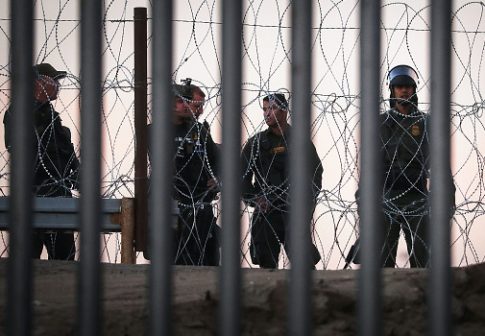There is an "unprecedented humanitarian and border security crisis all along our Southwest Border," U.S. Customs and Border Protection chief Kevin K. McAleenan told reporters Wednesday, as apprehensions hit record highs in the month of March.
CBP expects that by the end of the month, it will have apprehended more than 100,000 thousand people attempting to cross the southwestern border both at and between ports of entry. This figure would be the highest monthly total in a decade. Ninety percent of arrivals were apprehended crossing between ports of entry.
This upsurge in means that fiscal year 2019 (which began last September) is already on track to see the highest numbers of apprehended illegal immigrants in at least the past five years.
The consequence of this surge is that CBP custody facilities, designed for much lower levels of immigration, are bursting at the seams.
"Here in El Paso, we have almost 3,500 migrants in custody this morning, in facilities designed for many fewer," McAleenan said Wednesday. "We had over 1,000 apprehensions on Monday. The vast majority are families from Central America."
Those 1,000 apprehensions are just part of the 12,000 apprehensions in the past week. By comparison, CBP said, 4,000 individuals in custody is a "high number" and 6,000 is a "crisis"—12,000 is "unprecedented."
The primary driver of this increase is not, as in years past, lone, working-age men, usually from Mexico. Rather, the balance has shifted, such that the overwhelming majority of individuals crossing the border are unaccompanied minors or members of families ("family units" in CBP parlance), primarily coming from the violence-ridden Northern Triangle countries of Honduras, Guatemala, and El Salvador.
Official figures on the number of family units and UACs apprehended are not yet available. But February of 2019 saw the most apprehensions of UACs and family units in six or so years that CBP has been tracking those figures; if the increase in overall apprehensions is any indicator, March looks set to be another record-busting month on this front as well.
This enormous inflow is taxing CBP’s resources to the breaking point. According to the agency, 40 percent of personnel are working on caring for, transporting, and processing apprehended families and children—leaving less manpower for the targeting of the rampant drug smuggling along the southwestern border.
In response, CBP is mobilizing additional officers, as well as using additional funding appropriated for FY 2019 to enhance medical resources (the agency is seeing many migrants with severe medical conditions), transportation, and law enforcement resources, and set up new processing facilities.
As Congress remains stalemated over border security, the crisis at the border only deepens. It remains to be seen when—or if—the upsurge in arrivals will abate.
